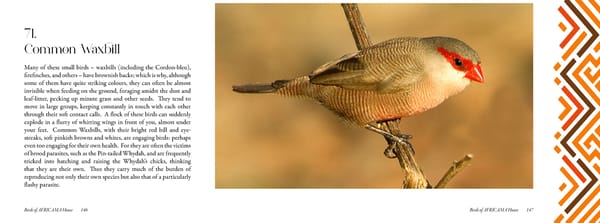71. Common Waxbill Many of these small birds – waxbills (including the Cordon-bleu), firefinches, and others – have brownish backs; which is why, although some of them have quite striking colours, they can often be almost invisible when feeding on the ground, foraging amidst the dust and leaf-litter, pecking up minute grass and other seeds. They tend to move in large groups, keeping constantly in touch with each other through their soft contact calls. A flock of these birds can suddenly explode in a flurry of whirring wings in front of you, almost under your feet. Common Waxbills, with their bright red bill and eye- streaks, soft pinkish browns and whites, are engaging birds: perhaps even too engaging for their own health. For they are often the victims of brood parasites, such as the Pin-tailed Whydah, and are frequently tricked into hatching and raising the Whydah’s chicks, thinking that they are their own. Thus they carry much of the burden of reproducing not only their own species but also that of a particularly flashy parasite. Birds of AFRICAMA House 146 Birds of AFRICAMA House 147
 Birds of Africama 1 Page 73 Page 75
Birds of Africama 1 Page 73 Page 75